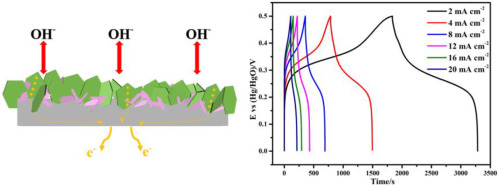Electrochimica Acta ( IF 5.5 ) Pub Date : 2020-03-29 , DOI: 10.1016/j.electacta.2020.136139 Jingbo Li , Wei Cao , Neng Zhou , Fang Xu , Nan Chen , Yu Liu , Guoping Du

|
Metal-organic frameworks (MOFs) have been widely used as templates for many nanomaterials and are considered to be a promising electrochemical energy storage material. However, while taking advantage of the unique porous structures of MOFs or MOFs’ derivatives, it is still a big challenge to have their conductivity improved to a large extent. Herein, a facile strategy is employed to prepare a hierarchical Ni-MOF-derived ternary composite, which is composed of nanosheet Ni(OH)2, MnO2 and graphite carbon. The Ni-MOF in-situ grown on nickel foam (NF) were used as template to prepare the Ni(OH)2-MnO2@C ternary composite, so that the self-supporting binder-free Ni(OH)2-MnO2@C/NF integrated electrode was resulted. The Ni(OH)2–MnO2@C composite had a hierarchical nanosheet structure. The as-prepared Ni(OH)2–MnO2@C/NF was found to exhibit a high specific capacity of 2.9C cm−2 (965.1C g−1) at a current density of 2 mA cm−2 and excellent cycle stability (capacity retention of 93.9% after 5000 cycles). Furthermore, the as-assembled Ni(OH)2–MnO2@C//activated carbon hybrid supercapacitor exhibited a high specific energy density of 39.1 Wh kg−1 with a power density of 221.4 W kg−1. One contribution for the superior electrochemical performance of the Ni(OH)2–MnO2@C composite is from its hierarchical nanostructure, which not only has a large specific surface area, but also provides efficient electron and ion transport channels as well as rich redox sites. Another contribution is from its excellent electrical conductivity as a result of the presence of graphitic carbon and the absence of non-conductive binder in the composite electrode as well as the direct contact between the electrode and current collector. This work provides an effective approach for fabricating high-performance composite electrodes from MOFs.
中文翻译:

源自镍泡沫塑料上生长的Ni-MOF的分层纳米结构Ni(OH)2 -MnO 2 @C三元复合材料,作为混合超级电容器的高性能集成电极
金属有机骨架(MOF)已被广泛用作许多纳米材料的模板,并被认为是一种有前途的电化学储能材料。但是,在利用MOF或MOF衍生物独特的多孔结构的同时,要使它们的电导率在很大程度上得到改善仍然是一个很大的挑战。在此,采用简便的策略制备由Ni-MOF衍生的三元复合材料,该复合材料由纳米片Ni(OH)2,MnO 2和石墨碳组成。以在泡沫镍(NF)上原位生长的Ni-MOF为模板制备Ni(OH)2 -MnO 2 @C三元复合材料,从而得到无粘结剂的自支撑Ni(OH)2 -MnO 2产生了@ C / NF集成电极。Ni(OH)2 -MnO 2 @C复合材料具有分层的纳米片结构。发现所制备的Ni(OH)2 -MnO 2 @ C / NF在2 mA cm -2的电流密度下表现出2.9C cm -2(965.1C g -1)的高比电容,并且循环性能优异稳定性(5000次循环后容量保留率为93.9%)。此外,组装后的Ni(OH)2 -MnO 2 @ C //活性炭混合超级电容器表现出39.1 Wh kg -1的高比能量密度和221.4 W kg -1的功率密度。Ni(OH)2 -MnO 2 @C复合材料优异的电化学性能的一个贡献是来自其分层的纳米结构,该结构不仅具有大的比表面积,而且还提供有效的电子和离子传输通道以及丰富的氧化还原网站。另一个贡献是由于复合电极中石墨碳的存在和不导电粘合剂的缺乏以及电极与集电器之间的直接接触,其优异的导电性。这项工作为从MOF制备高性能复合电极提供了有效的方法。











































 京公网安备 11010802027423号
京公网安备 11010802027423号